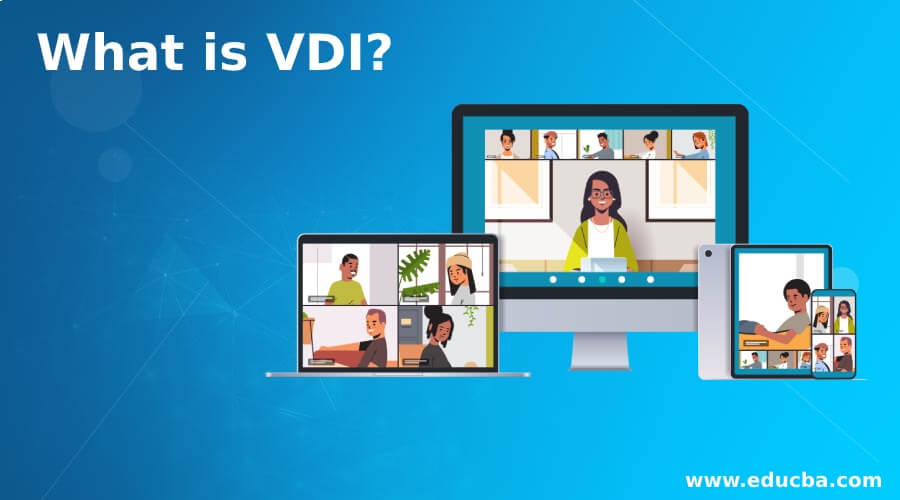Updated April 12, 2023

What is VDI?
Virtual desktop infrastructure (VDI) is a virtualized desktop technology that operates and is managed in a data center on desktop operating systems such as Microsoft Windows. The virtual desktop image would be transmitted to an endpoint computer over a network, enabling the user to contact the operating system and its software as if it were locally operating. A conventional PC, a small consumer or a handheld device can provide the endpoint. The idea that users present virtual software and desktops is part of end-user computing (EUC). VMware invented the word VDI which has been a de facto technical acronym since. Although the most popular workload is Windows-based VDI, Linux virtual desktops are also an alternative. Additional advantages of the VDI solution are authentication and configuration management. As the absence of an endpoint computer in the data center reduces the exposure of data not contained on the device. A VDI instance includes robust controls to remove divergence from organizational expectations in settings of uniform desktop configurations that do not have to be personalized for each user.
How to Implement VDI?
Planning for VDI rollout should involve bigger companies in the introduction of HCI as the scalability and high efficiency of HCI is a natural match for VDI’s resource needs. On the other hand, it is possible that implementing VDI HCI for organizations needing under 100 virtual desktops is not appropriate. There are many best practices for incorporating VDI, in addition to infrastructure requirements.
- Avoid under-provisioning: Perform power preparation in advance using a performance management tool that knows the resources that each desktop uses and guarantees that you are mindful of the total demands for resources.
- Understand your end-users’ needs: Do the users have to be willing, or are they task men who can work on a common desktop?? What are the efficiency needs of your users? For those who use graphics-heavy software, you need to set up the configuration differently relative to those using only internet connectivity or one or two basic applications.
- Prepare your network: Given that VDI efficiency is so closely related to network performance, peak use times and demand changes must be understood to ensure adequate network capability.
- Perform a pilot test: Most virtualization providers have software to monitor VDI implementations in advance, so that you are confident that your services have been properly supplied
Benefits of VDI
Although VDI’s difficulty ensures that not always every company has the right option, it provides organizations that use it with a variety of benefits. Such advantages include:
- Cost Saving: The hardware specifications for end devices are also smaller as the work is performed on the cloud. Benutzers can access virtual desktops from older computers, small customers or even tablets which reduce the need for IT to buy costly new hardware.
- Security: Data resides on the server in a VDI system instead of the end customer computer. This preserves data when an endpoint computer is stolen or damaged.
- Remote access: VDI users can connect from any place or laptop to their virtual machine, making it easier for workers to have access to all of their files and apps and to operate remotely worldwide.
Uses of VDI
- Remote Workers: The use of VDI environments makes access to the typical corporate workspace environments across a wide variety of platforms simpler for remote staff. With the virtual desktop it is possible to monitor access to core information systems and allow any remote worker to be reached on a remote site with limited investment. Each team member has access to the same organizational network and services regardless of location and thus retaining leverage over central access and application. Persistent desktops may be modified to accommodate any user, while data remains central to the central data center.
- Contract Employees: When temporary contractor members join a project, it is crucial to have access to certain main assets and team members. Using an online desktop, access to organizational services can be managed by supplying temporary employees with a link point. Contractors can carry out activities using corporate tools without accessing contract-related structures. This monitoring often decreases the cost in a physical endpoint system over the contract duration as much as possible.
- Call Centers: A big benefit of the non-permanent desktop is the option to select a regular desktop from the same desktop pool. The traditional call center shows well how this paradigm meets the needs of a team. Team members must carry out a particular set of activities, which are not non-standard for the desktop. The opportunity to only access to an accessible laptop during working hours minimizes the overhead to supply actual desktop computers with a staff that can flex up or down.
Recommended Articles
This is a guide to What is VDI?. Here we also discuss the introduction and how to implement VDI? along with uses and benefits. You may also have a look at the following articles to learn more –
